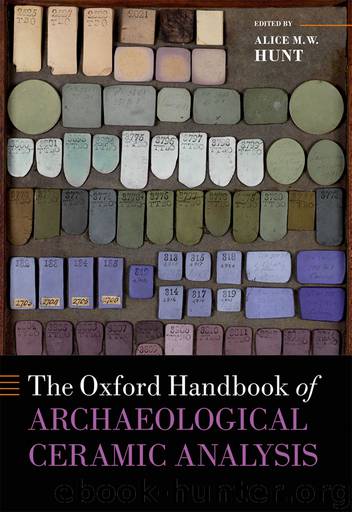The Oxford Handbook of Archaeological Ceramic Analysis by Alice M. W. Hunt

Author:Alice M. W. Hunt
Language: eng
Format: epub
Publisher: Oxford University Press
Published: 2017-03-09T16:00:00+00:00
PHYSICS OF X-RAY FLUORESCENCE
Although X-rays have long been used to image the skeletal structures, or to examine the contents of bags and packages at security checkpoints, our interest herein is the secondary (or fluoresced) X-rays that occur when an object is subjected to X-ray radiation. Photons from the primary or incident X-ray beam, with an energy between 5 and 100 keV (Rouessac and Rouessac, 2007: 263), displace electrons in the K, L, and M orbitals of atoms forming the surface of the sample. Secondary X-rays are formed when electrons from the higher orbitals release energy to fill voids in the lower orbitals (i.e. L orbital electrons drop to the K orbit, while M orbital electrons drop to the L orbit, etc.). An L orbital electron drops to the K orbit and loses energy; the energy loss is measured as Kα and Kβ X-rays. The Lα and Lβ X-rays are produced when an M orbital electron drops down to the L orbital. As the atomic number (Z) increases, the number of resulting secondary X-rays (such as Kα, Kβ, Lα, Lβ, etc.) and their intensity increases.
Not all the incident X-ray photons produce secondary X-rays. Depending on the energy of the incident X-ray, a certain percentage of the photons can end up producing Auger electrons instead of secondary X-rays, and another percentage of them can be coherently and incoherently scattered. Alternatively, if too powerful, incident photons can pass through the sample’s atoms and not produce any secondary X-rays or be scattered. Efficient production of secondary X-rays occurs when the incident photons have energy just slightly greater than the binding energy (also known as the absorption edge) of the K orbitals.1 For example, Ca, which has a binding energy of 4.03 keV, has a cross-section of 616 cm2/gm at 5 keV, but at 30 keV has a cross-section of only 4 cm2/gm.2 At 5 keV, Rb has a high cross-section at 386 cm2/gm, but its binding energy is 15.2 keV—thus, an incident photon with an energy of 5 keV would not have enough energy to displace an electron in the K orbital of a Rb atom. Despite having a lower cross-section of 20.2 cm2/g at 30 keV, the incident energy is more than sufficient to produce secondary X-rays. It is for this reason that different tube voltages are commonly used to detect elements of interest and multiple runs are needed. As noted by Janssen (2003: 371): “An element can therefore be determined with high sensitivity by means of XRF when the exciting radiation has its maximum intensity at an energy just above an absorption edge of that element.”
Coherent X-ray scattering is the basis for X-ray diffraction (see van der Veen and Pfeiffer, 2004). Incoherent scattering, also known as Compton scattering, is where the photon strikes an electron in the orbital of the atom, and loses part of its energy and is deflected in a different direction. For non-destructive ED-XRF and WD-XRF, this incoherent scattering is important since it is a function of the size and thickness of the sample.
Download
This site does not store any files on its server. We only index and link to content provided by other sites. Please contact the content providers to delete copyright contents if any and email us, we'll remove relevant links or contents immediately.
How to Be a Bawse: A Guide to Conquering Life by Lilly Singh(6703)
Spare by Prince Harry The Duke of Sussex(4222)
Millionaire: The Philanderer, Gambler, and Duelist Who Invented Modern Finance by Janet Gleeson(3576)
Harry Potter 02 & The Chamber Of Secrets (Illustrated) by J.K. Rowling(3293)
Urban Outlaw by Magnus Walker(2952)
The Heroin Diaries by Nikki Sixx(2941)
Never by Ken Follett(2910)
Japanese Design by Patricia J. Graham(2562)
The Club by A.L. Brooks(2374)
Machine Learning at Scale with H2O by Gregory Keys | David Whiting(2319)
The Man Who Died Twice by Richard Osman(2310)
Stacked Decks by The Rotenberg Collection(2283)
Harry Potter and the Deathly Hallows (7) by J.K. Rowling(2225)
Fairy Tale by Stephen King(2090)
Will by Will Smith(2061)
Harry Potter and the Prisoner of Azkaban (Book 3) by J. K. Rowling(2046)
Churchill by Paul Johnson(2017)
The Chimp Paradox by Peters Dr Steve(1865)
The 7 Habits of Highly Effective People: Powerful Lessons in Personal Change (25th Anniversary Edition) by Covey Stephen R(1841)
